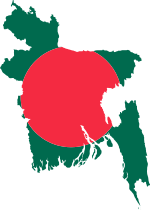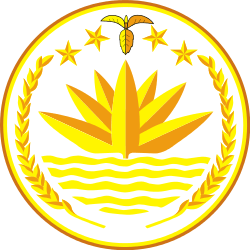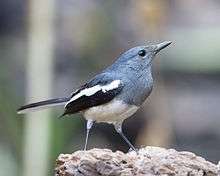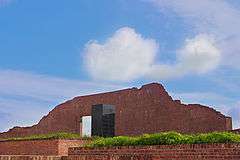National symbols of Bangladesh

| Part of a series on the |
| Culture of Bangladesh |
|---|
|
Rice Bread Fish Sweets Snacks Sauce |
| Religion |
|
Architects Painters Sculptor |
|
Literature History Genres Institutions Awards Writers |
|
Music and performing arts |
|
Monuments |
|
The national symbols of the Bangladesh consist of symbols to represent Bangladeshi traditions and ideals that reflect the different aspects of the cultural life and history. Bangladesh has several official national symbols including a historic document, a flag, an emblem, an anthem, memorial towers as well as several national heroes. There are also several other symbols including the national animal, bird, flower and tree.
Flag
 |
The national Flag of Bangladesh (বাংলাদেশের জাতীয় পতাকা), known as Red-Green, was adopted officially on 17 January 1972. It consists of a red disc on top of a green field, offset slightly toward the hoist so that it appears centred when the flag is flying. The red disc represents the sun rising over Bengal, and also the blood of those who died for the independence of Bangladesh. The green field stands for the lushness of the land of Bangladesh.[1] The flag is based on a similar flag used during the Bangladesh Liberation War of 1971, which had a yellow map of the country inside the red disc. In 1972 this map was deleted from the flag. One reason given was the difficulty for rendering the map correctly on both sides of the flag. The civil ensign and naval ensign place the national flag in the canton of a red or white field, respectively. |
Emblem
 |
The national emblem of Bangladesh (বাংলাদেশের জাতীয় প্রতীক) was adopted shortly after independence in 1971. Located on the emblem is a water lily, that is bordered on two sides by rice sheaves. Above the water lilly are four stars and a three connected jute leaves. The water lily is the country's national flower, and is representative of the many rivers that run through Bangladesh. Rice represents its presence as the staple food of Bangladesh, and for the agriculture of that nation. The four stars represent the four founding principles in the current constitution of Bangladesh of 1972: nationalism, secularism, socialism, and democracy.[2][3] |
Government seal
 |
The Government Seal of Bangladesh (বাংলাদেশ সরকার সীলমোহর) used by the Ministries of Bangladesh[4] and the Government of Bangladesh[5] on official documents. One version is used on the cover page of Bangladeshi passports.[6]
The seal features the same design elements as the first Flag of Bangladesh in a circular setting. The outer white ring is shown with the caption of the official name of the Government of the People's Republic of Bangladesh in Bengali: গণপ্রজাতন্ত্রী বাংলাদেশ সরকার with 4 red 5-pointed stars. In centre the country map on a red disc. |
National anthem
Amar Sonar Bangla (আমার সোনার বাংলা, "My Golden Bengal") is song written and composed by the Bengali poet Rabindranath Tagore, the first ten lines of which were adopted in 1972 as the national anthem of Bangladesh.[7] The song was written in 1905 during the period of বঙ্গভঙ্গ Bônggôbhônggô (Partition of Bengal (1905)) - when the ruling British empire had the province of Bengal split into two parts. This song, along with a host of others, was written by Tagore, a pioneer of the cultural and political movement against this partition. These songs were meant to rekindle the unified spirit of Bengal, to raise public consciousness against the communal political divide. The lyrics first appeared in the September issues of "Bongodorshon" and "Baul" simultaneously, in 1905. It is said that the music of this song was inspired by the Baul singer Gagan Harkara's song কোথায় পাবো তারে "Kothay Pabo Tare".[8] The instrumental orchestra rendition was composed by Samar Das.[9] The English translation was done by Syed Ali Ahsan.
National march
Notuner Gaan (Bengali: নতুনের গান, Natunēra gāna) is the national march (Bengali: রণ-সঙ্গীত) of Bangladesh.[10] This song is written by Kazi Nazrul Islam, the national poet of Bangladesh (also known as 'rebel poet'), in 1929. This song is belongs to his famous book titled as The Evening (Sôndhya: সন্ধ্যা). Nazrul is the musician of the song too. On 13 January 1972, the ministry of Bangladesh has adopted this song as a national marching song on its first meeting after the country's independence.[10] At any military ceremony or function, first 21 lines of the song is being played. It is also known as the national military song of Bangladesh.[11]
Flora and fauna
.jpg) |
The shapla (Nymphaea nouchali) is the national flower of Bangladesh. Nymphaea nouchali is considered a medicinal plant in Indian Ayurvedic medicine under the name ambal; it was mainly used to treat indigestion.[12] Recent experiments have confirmed that it has medicinal qualities as an antihepatotoxic and antidiabetic.[13][14] Like all waterlilies or lotuses, its tubers and rhizomes can be used as food items; they are eaten usually boiled or roasted. In the case of N. nouchali, its tender leaves and flower peduncles are also valued as food.[15] |
| |
The jackfruit (Artocarpus heterophyllus) is the national fruit of Bangladesh. It is native to parts of South and Southeast Asia and widely cultivated in tropical regions of Bangladesh. The jackfruit tree is well suited to tropical lowlands, and its fruit is the largest tree-borne fruit,[16] reaching as much as 80 pounds (36 kg) in weight, 36 inches (90 cm) in length, and 20 inches (50 cm) in diameter.[17] |
| |
The mango (Mangifera indica) is the national tree of Bangladesh. The mango is native to South Asia, from where it has been distributed worldwide to become one of the most cultivated fruits in the tropics. Its fruit and leaves are ritually used as floral decorations at weddings, public celebrations and religious ceremonies.[18] |
 |
The royal Bengal tiger (Panthera tigris tigris) is the national animal of Bangladesh. Its populations have been estimated at 440 in Bangladesh.[19][20] Tigers in Bangladesh are now relegated to the forests of the Sundarbans and the Chittagong Hill Tracts.[19] The tiger replaces the lion as king of the beasts in cultures of eastern Asia representing royalty, fearlessness and wrath.[21] Members of the East Bengal Regiment of the Bangladesh Army are nicknameed 'Bengal Tigers'; the regiment's logo is a tiger face and the Bangladesh Cricket Board's logo features a royal Bengal tiger. |
| |
The ilish (Bengali: ইলিশ) or hilsha, also spelled elish (Tenualosa ilisha), is national fish of Bangladesh. As it is anadromous in nature (an uncommon phenomenon in tropical waters), the ilish lives in the sea for most of its life, but migrates up to 1,200 km inland through rivers in the Indian sub-continent for spawning. Distances of 50–100 km are usually normal in the Bangladeshi rivers. The ilish is a popular fish to eat among the people of South Asia.[22][23] |
 |
The magpie robin (Copsychus saularis) is the national bird of Bangladesh, where it is common and known as the doyel or doel (Bengali: দোয়েল). They are common birds in urban gardens as well as forests. They are particularly well known for their songs and were once popular as cagebirds. It is a widely used symbol in Bangladesh, appearing on currency notes, and a landmark in the city of Dhaka is named as the Doyel Chatwar (meaning: Doyel Square). |
National monuments and memorials
Shaheed Minar
| |
The Shaheed Minar (শহীদ মিনার Shôhid Minar lit. "Martyr Monument") is a national monument in Dhaka, Bangladesh, established to commemorate those killed during the Bengali Language Movement demonstrations of 1952.
The enormous design includes half-circular columns to symbolize the mother, with her fallen sons, standing on the monument's central dais, and the red sun shining behind. The Central Shaheed Minar of Dhaka goes up to a height of 14 metres (46 ft) and was made with marble stones. The stairs and barrier are highlighted in white, to create a divine look. The fence on both sides is painted with lines from poems of legendary poets in iron letters. As the visitors enter the monument they will find two statues of the patriots who sacrificed their lives in that heinous police firing of 1952. The marble floor was designed to reveal the moving shadows of the columns. The basement of the Shaheed Minar also included a 1,500-square-foot (140 m2) mural representing the history of the Language Movement.[24] The Language Movement was one of the formidable movements which has come up in the country of Bangladesh, thus the Central Shaheed Minar epitomizes efforts to represent the spirit of Bangladeshi nationalism and also highlight the importance of the Bengali language in the social and cultural progress of the country. As a result, the Shaheed Minar has a very significant place in the social and cultural mechanism of Bangladesh. At present, all national, mourning, cultural and other activities held each year, regarding 21 February, have been centered around the Shaheed Minar. |
Jatiyo Smriti Soudho
 |
The Jatiyo Sriti Shoudho (জাতীয় স্মৃতি সৌধ Jatiyô Smrriti Soudhô) or National Martyrs' Memorial is the national monument of Bangladesh is the symbol in the memory of the valour and the sacrifice of all those who gave their lives in the Bangladesh Liberation War of 1971, which brought independence and separated Bangladesh from Pakistan. The monument is located in Savar, about 35 km north-west of the capital, Dhaka.[25] It was designed by Syed Mainul Hossain.
The monument is composed of 7 isosceles triangular pyramid shaped structures, with the middle one being the tallest. The highest point of the monument is 150 feet. There is an artificial lake, and several mass graves in front of the main monument. There is a Green house, PWD site office, VVIP and VIP waiting room inside the area. |
Martyred Intellectuals Memorial
 |
The Martyred Intellectuals Memorial (বুদ্ধিজীবি স্মৃতি সৌধ) is a memorial built in memory of the martyred intellectuals of Bangladesh Liberation War. The memorial, located at Rayerbazar, Mohammadpur Thana in Dhaka,[26] was designed by architect Farid U Ahmed and Jami Al Shafi.[27][28][29]
During the entire duration of Bangladesh Liberation War of 1971, a large number of teachers, doctors, engineers, poets and writers were systematically massacred by Pakistan Army and their local collaborators, most notably the alleged Islamist militia groups Al-Badr and Al-Shams. The largest number of assassinations took place on 14 December 1971, only two days before the surrender of Pakistan army to the joint force of Indian army and Mukti bahini. The initial proposal for a memorial at Rayer Bazar was brought forward by Projonmo 71 (organisation of the children of the martyrs of liberation war), who also laid a temporary foundation stone in 1991. |
Other national and official symbols
| Title | Symbol and notes |
|---|---|
| Official name | গণপ্রজাতন্ত্রী বাংলাদেশ Gônôprôjatôntri Bangladesh People's Republic of Bangladesh |
| State religion | The state religion is Islam, but with the equal status and equal right in the practice of the Hindu, Buddhist, Christian and other religions.[30] |
| Father of the nation | শেখ মুজিবুর রহমান (বঙ্গবন্ধু) Shekh Mujibur Rôhman (BônggôBôndhu, "Friend of Bengal") |
| National hero | মুহাম্মদ আতাউল গনি ওসমানী (বঙ্গবীর) Muhammôd Ataul Gôni Osmani (Bônggôbir, "Brave Bengali"). |
| Historical hero | নবাব সিরাজ উদ-দাউলা Nôbab Siraj ud-Daula[31] |
| Document | পাকিস্তান সেনাবাহিনীর আত্মসমর্পনের দলিল Surrender Instrumental document of the Pakistan Army - 1971 |
| National poet | কাজী নজরুল ইসলাম Kazi Nôzrul Islam |
| National language | বাংলা Bangla |
| National personification | বাংলা মা Bangla Ma |
| National calendar | বঙ্গাব্দ Bônggabdô |
| National dress | Sari (female) and Lungi+Gamcha (male) |
| Mammal | গঙ্গা নদী শুশুক Ganges river dolphin |
| National river | যমুনা Jômuna |
| National game | কাবাডি Kabadi (Ha-Du-Du) |
| National park | ভাওয়াল জাতীয় উদ্যান Bhawal National Park |
| National mosque | বায়তুল মুকাররম Baitul Mukarrôm |
| National temple | ঢাকেশ্বরী জাতীয় মন্দির Dhakeshôri Temple |
| Mountain | কিওক্রাডাং Keokradong |
| National museum | বাংলাদেশ জাতীয় যাদুঘর National Museum of Bangladesh |
| National library | বাংলাদেশ জাতীয় গ্রন্থাগার National Library of Bangladesh |
References
- ↑ "Flag description". The world fact book. CIA USA. Retrieved 2013-09-11.
- ↑ A Hossain; G Kabir; M M Ud-deen & A M S Alam (2007). "Cytological studies of Nymphaea species available in Bangladesh". Journal of Bio-Science. 15: 7–13.
- ↑ http://www.supremecourt.gov.bd/scweb/constitution/pdf/04_part1-4.pdf
- ↑ http://www.bangladesh.gov.bd/index.php?option=com_weblinks&task=ministry&Itemid=152
- ↑ http://www.virtualbangladesh.com/state.html
- ↑ http://www.dip.gov.bd
- ↑ "Bangladesh: Amar Sonar Bangla". NationalAnthems.me. Retrieved 2011-08-09.
- ↑ Folk singer, Swapan Basu, demonstrates the similarity in a live recitation (0:43/8:46 to 1:21/8:46)
- ↑ Komol, Khalid Hasan (2012). "Das, Samar". In Islam, Sirajul; Jamal, Ahmed A. Banglapedia: National Encyclopedia of Bangladesh (Second ed.). Asiatic Society of Bangladesh.
- 1 2 "India-Bangladesh Joint Celebration, 113th birth anniversary of Poet Kazi Nazrul Islam and 90th year of his poem `Rebel'". Prime Minister's Office, Government of the People's Republic of Bangladesh. Retrieved 2013-09-23.
- ↑ "The rebel poet". The Daily Star. Retrieved 2013-09-23.
- ↑ P. V. Sharma, Puṣpāyurvedaḥ - Pradhāna vitaraka Caukhambhā Bhāratī Akādamī, 1998
- ↑ MR Bhandarkar; A Khan (2004). "Antihepatotoxic effect of Nymphaea stellata Willd., against carbon tetrachloride-induced hepatic damage in albino rats". Journal of Ethnopharmacology. 91 (1): 61–64. doi:10.1016/j.jep.2003.11.020. PMID 15036469.
- ↑ K Rajagopal, K Sasikala -Antidiabetic activity of hydro-ethanolic extracts of Nymphaea Stellata flowers- African Journal of Pharmacy and Pharmacology, 2008
- ↑ FR Irvine, RS Trickett - Waterlilies as Food - Kew Bulletin, 1953
- ↑ "Jackfruit, Breadfruit & Relatives". Know & Enjoy Tropical Fruit. 2012. Retrieved 2012-11-23.
- ↑ "JACKFRUIT Fruit Facts". California Rare Fruit Growers, Inc. 1996. Retrieved 2012-11-23.
- ↑ "Mango tree, national tree". 2010-11-15. Retrieved 2013-11-16.
- 1 2 Khan, M. M. H. (2004). Ecology and conservation of the Bengal tiger in the Sundarbans Mangrove forest of Bangladesh. PhD thesis, University of Cambridge.
- ↑ Ministry of Environment and Forests. (2004). Report on Sundarbans Tiger Census. Ministry of Environment and Forests, Bangladesh.
- ↑ Cooper, J. C. (1992). Symbolic and Mythological Animals. London: Aquarian Press. pp. 226–27. ISBN 1-85538-118-4.
- ↑ "Govt likely to review ban on hilsa export | Dhaka Tribune". archive.dhakatribune.com. Retrieved 2016-08-03.
- ↑ Daniyal, Shoaib. "India-Bangladesh relations are so good that Dhaka might even lift its hilsa export ban". Retrieved 2016-08-03.
- ↑ Islam, Rafiqul (2000). Amar Ekushey O Shaheed Minar (in Bangla). Dhaka: Poroma. p. 58. ISBN 984-8245-39-1.
- ↑ Amin, Md Shahidul; Islam, M Zakiul (2012). "National Martyrs' Memorial". In Islam, Sirajul; Jamal, Ahmed A. Banglapedia: National Encyclopedia of Bangladesh (Second ed.). Asiatic Society of Bangladesh.
- ↑ Ahmed, Syed Shabbir (2012). "Mohammadpur Thana (Dhaka Metropolitan)". In Islam, Sirajul; Jamal, Ahmed A. Banglapedia: National Encyclopedia of Bangladesh (Second ed.). Asiatic Society of Bangladesh.
- ↑ Amin, Md. Shahidul (2012). "Badhya Bhumi Smriti Soudha". In Islam, Sirajul; Jamal, Ahmed A. Banglapedia: National Encyclopedia of Bangladesh (Second ed.). Asiatic Society of Bangladesh.
- ↑ Star Magazine
- ↑ Seven Icons of History at Dhaka
- ↑ "Constitution of Bangladesh". Ministry of Law, Justice and Parliamentary Affairs, Government of Bangladesh. Retrieved 2013-11-11.
- ↑ the last independent nawab of Bengal.